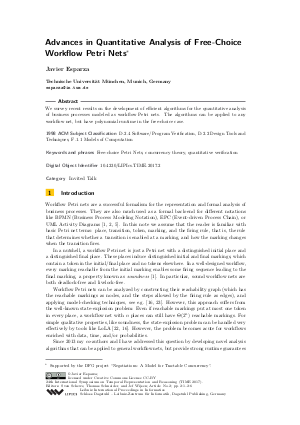Advances in Quantitative Analysis of Free-Choice Workflow Petri Nets (Invited Talk)
Author Javier Esparza
-
Part of:
Volume:
24th International Symposium on Temporal Representation and Reasoning (TIME 2017)
Part of: Series: Leibniz International Proceedings in Informatics (LIPIcs)
Part of: Conference: International Symposium on Temporal Representation and Reasoning (TIME) - License:
 Creative Commons Attribution 3.0 Unported license
Creative Commons Attribution 3.0 Unported license
- Publication Date: 2017-09-25
File

PDF
LIPIcs.TIME.2017.2.pdf
- Filesize: 354 kB
- 6 pages
Document Identifiers
Subject Classification
Keywords
- Free-choice Petri Nets
- concurrency theory
- quantitative verification
Metrics
- Access Statistics
-
Total Accesses (updated on a weekly basis)
0Document
0Metadata
Abstract
We survey recent results on the development of efficient algorithms for the quantitative analysis of business processes modeled as workflow Petri nets. The algorithms can be applied to any workflow net, but have polynomial runtime in the free-choice case.
Cite As Get BibTex
Javier Esparza. Advances in Quantitative Analysis of Free-Choice Workflow Petri Nets (Invited Talk). In 24th International Symposium on Temporal Representation and Reasoning (TIME 2017). Leibniz International Proceedings in Informatics (LIPIcs), Volume 90, pp. 2:1-2:6, Schloss Dagstuhl – Leibniz-Zentrum für Informatik (2017)
https://doi.org/10.4230/LIPIcs.TIME.2017.2
BibTex
@InProceedings{esparza:LIPIcs.TIME.2017.2,
author = {Esparza, Javier},
title = {{Advances in Quantitative Analysis of Free-Choice Workflow Petri Nets}},
booktitle = {24th International Symposium on Temporal Representation and Reasoning (TIME 2017)},
pages = {2:1--2:6},
series = {Leibniz International Proceedings in Informatics (LIPIcs)},
ISBN = {978-3-95977-052-1},
ISSN = {1868-8969},
year = {2017},
volume = {90},
editor = {Schewe, Sven and Schneider, Thomas and Wijsen, Jef},
publisher = {Schloss Dagstuhl -- Leibniz-Zentrum f{\"u}r Informatik},
address = {Dagstuhl, Germany},
URL = {https://drops.dagstuhl.de/entities/document/10.4230/LIPIcs.TIME.2017.2},
URN = {urn:nbn:de:0030-drops-79266},
doi = {10.4230/LIPIcs.TIME.2017.2},
annote = {Keywords: Free-choice Petri Nets, concurrency theory, quantitative verification}
}
Author Details
References
-
Wil van der Aalst. The application of Petri nets to workflow management. Journal of Circuits, Systems, and Computers, 8(1):21-66, 1998.

-
Wil van der Aalst and Kees Max van Hee. Workflow management: models, methods, and systems. MIT press, 2004.

-
Wil van der Aalst, Alexander Hirnschall, and Eric Verbeek. An alternative way to analyze workflow graphs. In Advanced Information Systems Engineering, volume 2348 of Lecture Notes in Computer Science, pages 535-552. Springer, 2002.

-
Mirela Botezatu, Hagen Völzer, and Lothar Thiele. The complexity of deadline analysis for workflow graphs with multiple resources. In BPM, volume 9850 of Lecture Notes in Computer Science, pages 252-268. Springer, 2016.

-
Jörg Desel and Thomas Erwin. Modeling, simulation and analysis of business processes. In Business Process Management, volume 1806 of Lecture Notes in Computer Science, pages 129-141. Springer, 2000.

-
Jörg Desel and Javier Esparza. Free choice Petri nets. Cambridge University Press, 2005.

-
Jörg Desel and Javier Esparza. Negotiations and Petri nets. Transactions in Petri Nets and Other Models of Concurrency, 11:203-225, 2016.

-
Jörg Desel, Javier Esparza, and Philipp Hoffmann. Negotiation as concurrency primitive. CoRR, abs/1612.07912, 2016.

-
Boudewijn van Dongen, Wil van der Aalst, and Eric Verbeek. Verification of EPCs: Using reduction rules and Petri nets. In Advanced Information Systems Engineering, pages 372-386. Springer, 2005.

-
Christian Eisentraut, Holger Hermanns, Joost-Pieter Katoen, and Lijun Zhang. A semantics for every GSPN. In PETRI NETS, volume 7927 of Lecture Notes in Computer Science, pages 90-109. Springer, 2013.

-
Javier Esparza and Jörg Desel. On negotiation as concurrency primitive. In CONCUR, volume 8052 of Lecture Notes in Computer Science, pages 440-454. Springer, 2013.

-
Javier Esparza and Jörg Desel. On negotiation as concurrency primitive II: Deterministic cyclic negotiations. In FoSSaCS, volume 8412 of Lecture Notes in Computer Science, pages 258-273. Springer, 2014.

-
Javier Esparza and Philipp Hoffmann. Reduction rules for colored workflow nets. In FASE, volume 9633 of Lecture Notes in Computer Science, pages 342-358, 2016.

-
Javier Esparza, Philipp Hoffmann, and Ratul Saha. Polynomial analysis algorithms for free choice probabilistic workflow nets. In QEST, volume 9826 of Lecture Notes in Computer Science, pages 89-104. Springer, 2016.

-
Javier Esparza, Anca Muscholl, and Igor Walukiewicz. Static analysis of deterministic negotiations. CoRR, abs/1704.04190, 2017. To appear in the Proceedings of LICS'17.

-
Dirk Fahland, Cédric Favre, Barbara Jobstmann, Jana Koehler, Niels Lohmann, Hagen Völzer, and Karsten Wolf. Instantaneous soundness checking of industrial business process models. In BPM, volume 5701 of Lecture Notes in Computer Science, pages 278-293. Springer, 2009.

-
Cédric Favre, Dirk Fahland, and Hagen Völzer. The relationship between workflow graphs and free-choice workflow nets. Information Systems, 47:197-219, 2015.

-
Cédric Favre, Hagen Völzer, and Peter Müller. Diagnostic information for control-flow analysis of Workflow Graphs (a.k.a. Free-Choice Workflow nets). In TACAS, volume 9636 of Lecture Notes in Computer Science, pages 463-479, 2016.

-
Joost-Pieter Katoen. GSPNs revisited: Simple semantics and new analysis algorithms. In ACSD, pages 6-11. IEEE Computer Society, 2012.

-
Flemming Nielson, Hanne Riis Nielson, and Chris Hankin. Principles of program analysis. Springer, 1999.

-
Wasim Sadiq and Maria E. Orlowska. Analyzing process models using graph reduction techniques. Information systems, 25(2):117-134, 2000.

- Karsten Schmidt. LoLA: A low level analyser. In ICATPN, volume 1825 of Lecture Notes in Computer Science, pages 465-474, 2000. Current version available at URL: http://www.service-technology.org.
-
Nikola Trcka, Wil M. P. van der Aalst, and Natalia Sidorova. Data-flow anti-patterns: Discovering data-flow errors in workflows. In CAiSE 2009, volume 5565 of Lecture Notes in Computer Science, pages 425-439, 2009.

-
Eric Verbeek, Moe Thandar Wynn, Wil van der Aalst, and Arthur ter Hofstede. Reduction rules for reset/inhibitor nets. Journal of Computer and System Sciences, 76(2):125-143, 2010.

